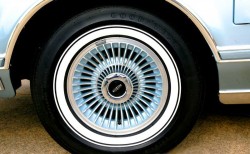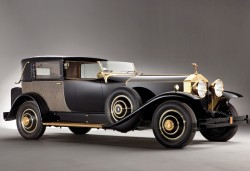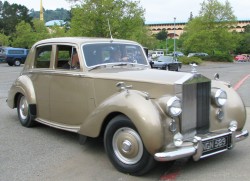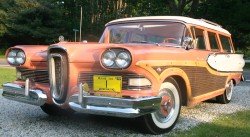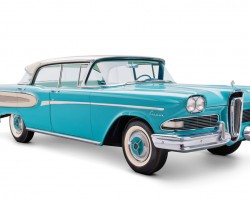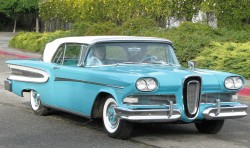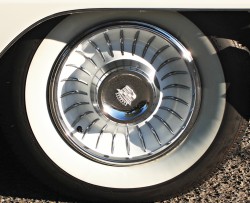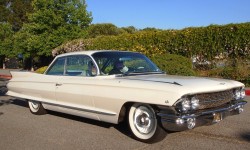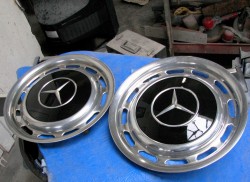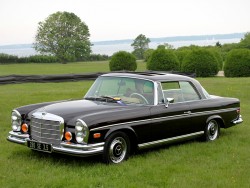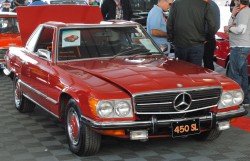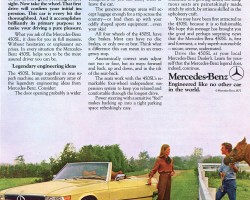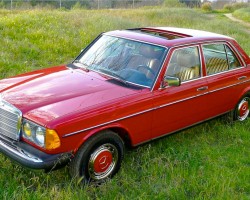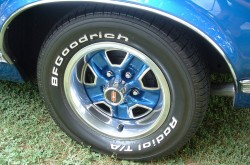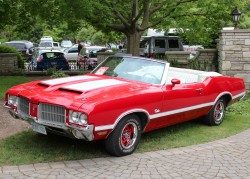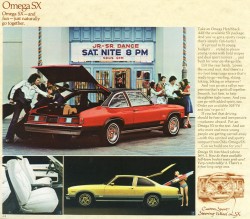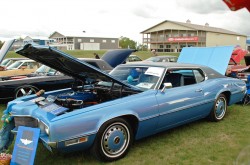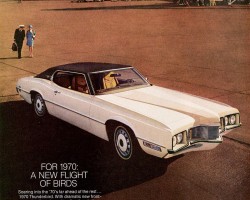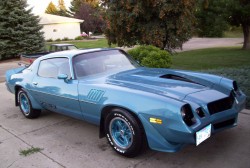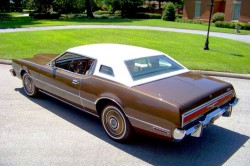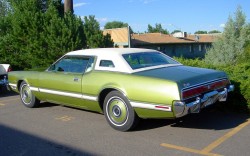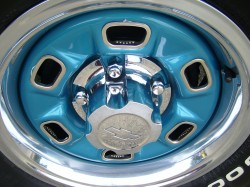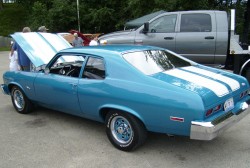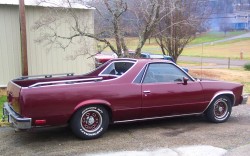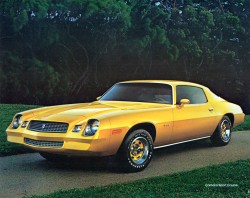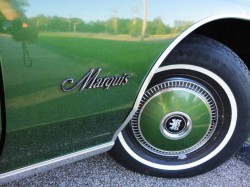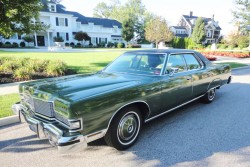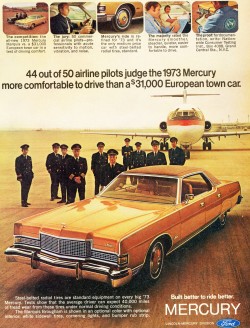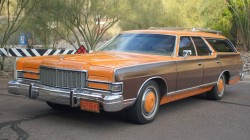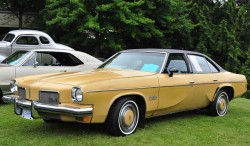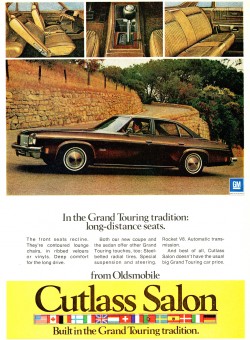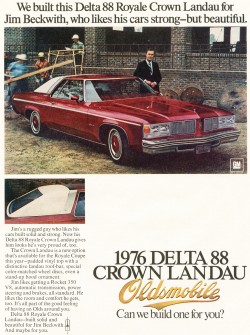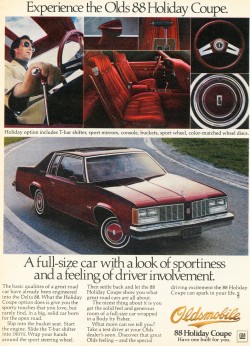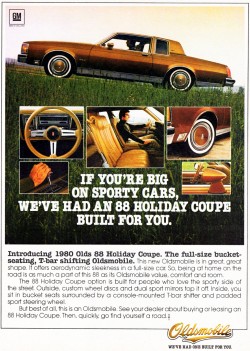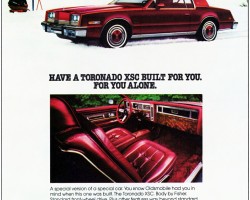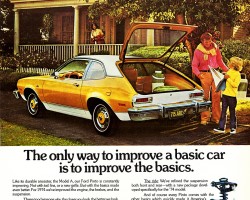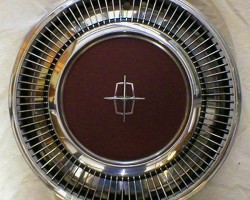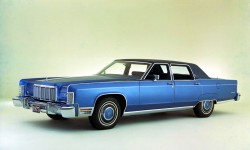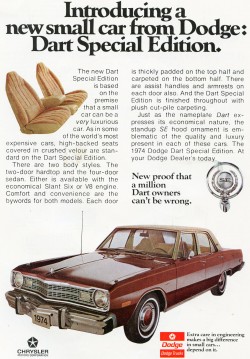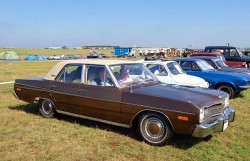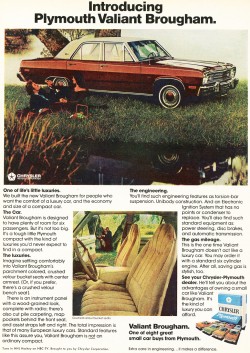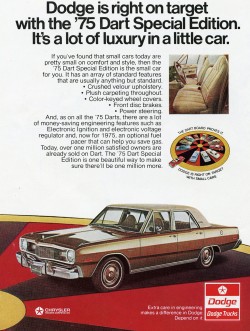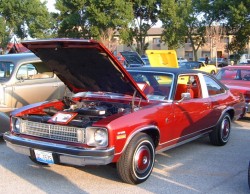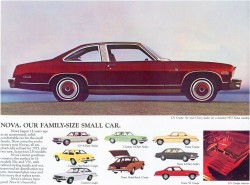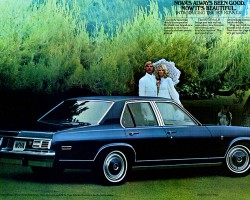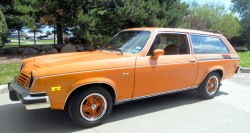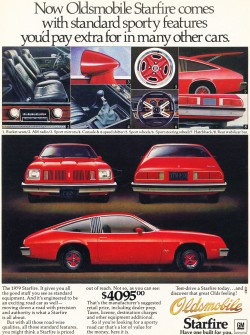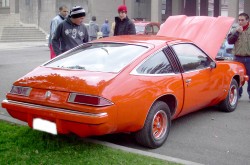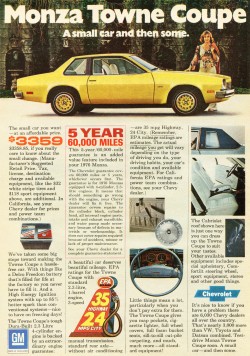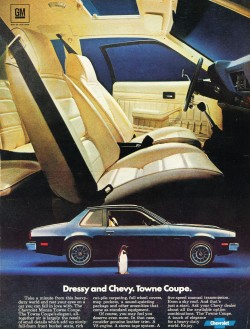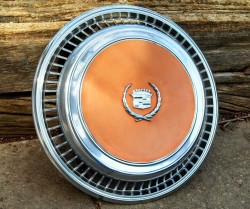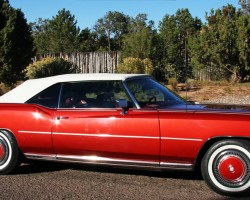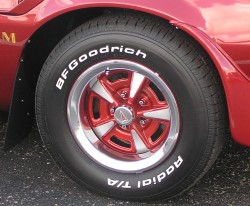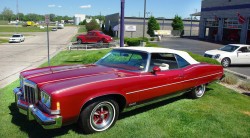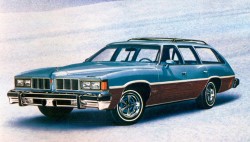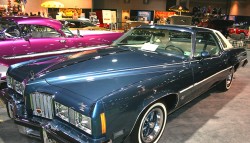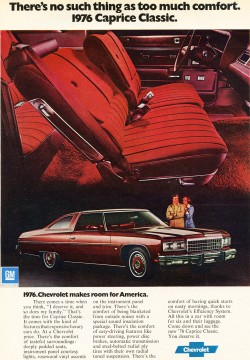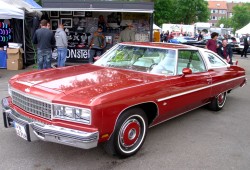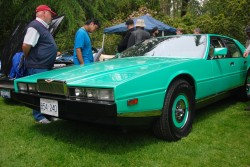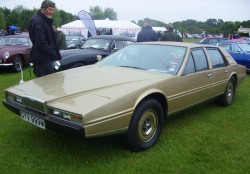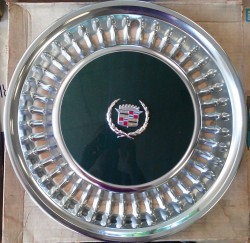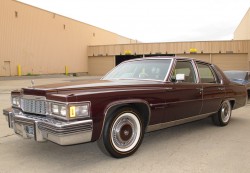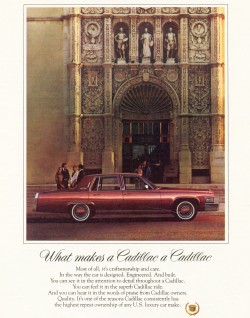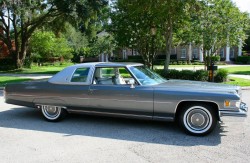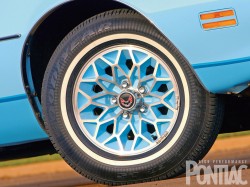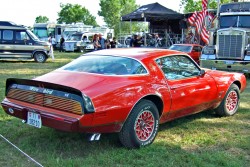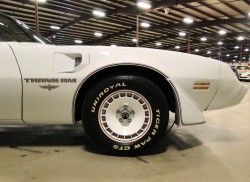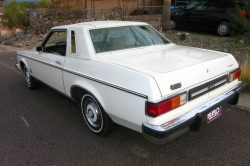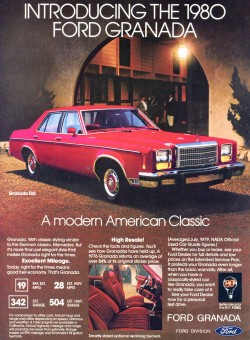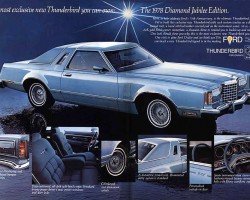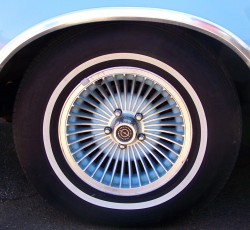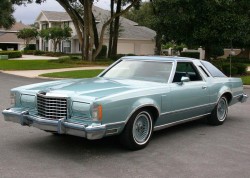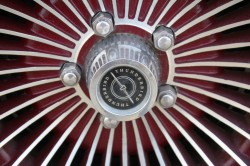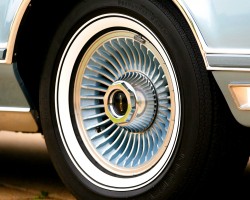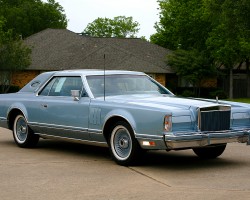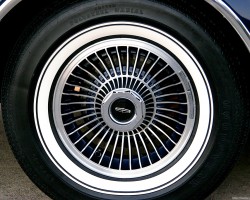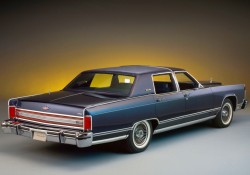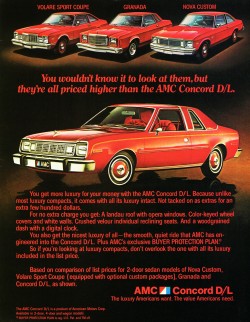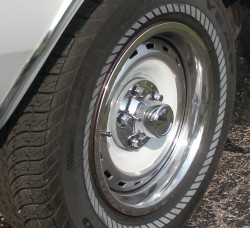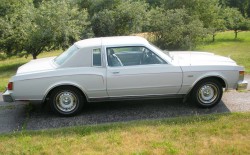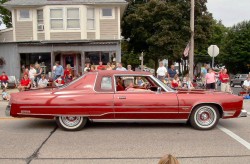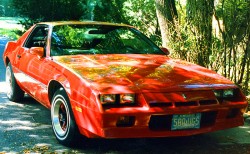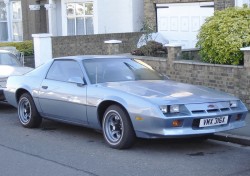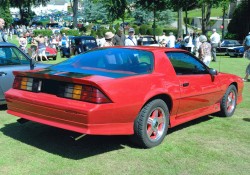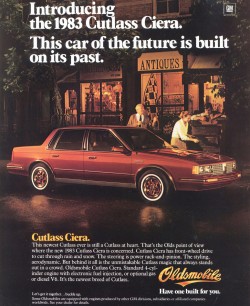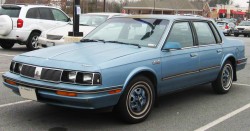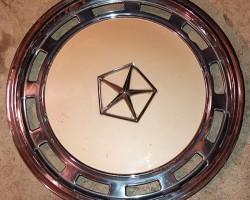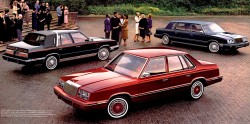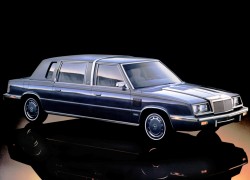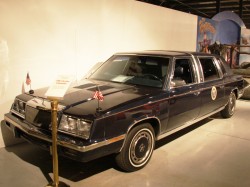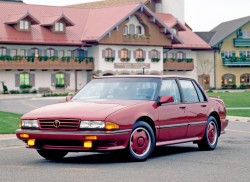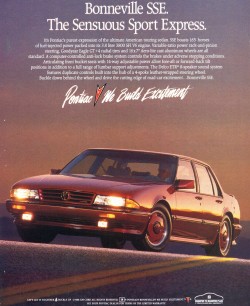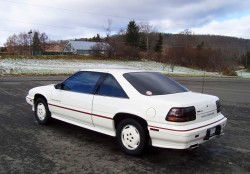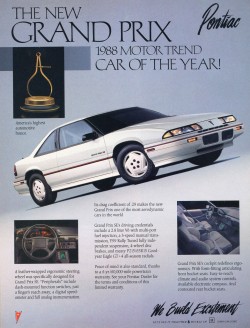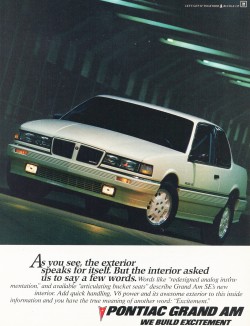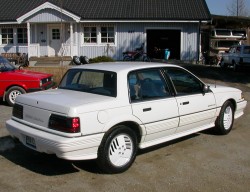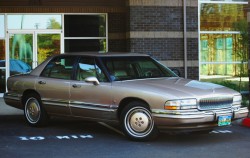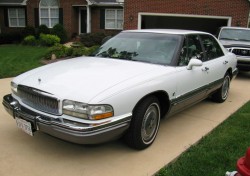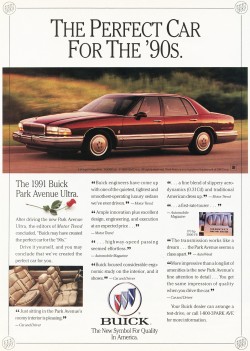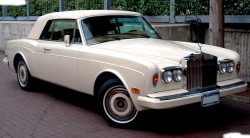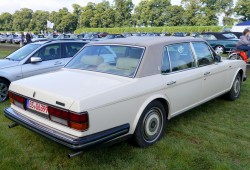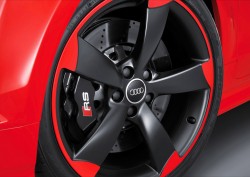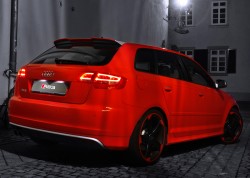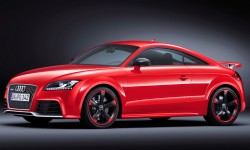
Audi is now equipping these color-matched wheels on high performance RS versions of several of its new models. (Photo: Sean Connor)
For a very small manufacturing cost, applying paint to a car’s wheels or wheel covers that matches body color can add a lot of visual interest to a vehicle’s profile. And if chrome trim or brightwork is applied tastefully with it, “sparkle” might be the right description for the effect. While automakers have been experimenting with this trick since the dawn of the automobile, it didn’t become a widespread fad on everyday cars until the 1970s.
SOME BRIEF HISTORY (see slideshow at end of article for a thorough visual tour of color-matched wheels and wheel covers)
Body color paint was widely used by most manufacturers to decorate wheels, spoked or otherwise, to an ornate level through the 1920s. Tougher Great Depression economic times during the 1930s and early ’40s dictated lower costs everywhere, so fancier wheel designs (even full wheel covers) were tossed in favor of cheap, small metal “hub caps” covering only center lug nuts and axle hubs. They became the norm on everything except high-end luxury cars such as Rolls-Royce or Bentleys.
To spruce up the dismal look of these plain wheels with small dog dishes glued onto them, most automakers painted the wheels the same color as the car. It cost nothing extra, but added a small amount of flair. While actual hub caps were used on price-leader versions of American cars until the early 1980s, they survive today only on police cars and taxis. For the purposes of this article, we’re focusing on full wheel covers and styled alloy wheels with paint specially applied to various embossed sections. (Minimal artistry is involved with plain colored wheels with center hub caps, and they’re not likely to ever return.)
As economic times boomed in the 1950s, full wheel covers returned. By the middle of the decade Mercedes began widespread use of one-piece color matched wheel covers, along with Edsel in 1958. Cadillac followed suit on their entire 1961-62 lineup, applying body matching paint in between chrome slats on styled wheel covers. While Cadillac’s interest in color matching was short lived, two of General Motors’ other divisions (Oldsmobile and Chevrolet) created styled steel wheels with paint appliques in the late 1960s. Both wheel designs proved so popular, they survived unchanged into the 1980s.
As color matching wheel covers grew in popularity on upscale cars in the early 1970s (Ford Thunderbird, Mercury Marquis, Lincoln Continental, Rolls Royce, Mercedes, Oldsmobile), the public began to associate them with luxury. After the 1973 gasoline shortage, automakers seeking to capture buyers ditching large luxury cars created more upscale versions of compact economy cars. Suddenly Ford Pintos, Dodge Darts, Chevrolet Novas, Chevrolet Vegas and newly created compact Buicks and Oldsmobiles were sporting painted wheel covers.
Pontiac went through two bursts of enthusiasm with multiple color matching wheel designs: the first spanning the late-1970s, and the second lasting from the mid-1980s until a decade later. Cadillac and Lincoln used color matching briefly in the late-1970s on their highest-priced models, followed by Chrysler in the early 1980s that mostly sought to emulate Mercedes-Benz (last use of color matched wheel covers was 1983 in the U.S.).
By the 1990s, only Pontiac and Rolls-Royce/Bentley were still using color matching on a large scale. From 1991-95, Buick briefly experimented with painted center caps on Park Avenue wheels. But by the end of the 1990s, the fad that had peaked in the 1970s was gone altogether.
WHAT’S OLD MAY BECOME NEW AGAIN
In the last several years, Audi has been offering wheels with color-matched edging on some of its highest performance RS models sold in Europe but not the United States. At this year’s New York auto show in April, Audi displayed them on their TT RS coupe. Perhaps they feel, as many do, that what’s old needs to be new again.
CLICK ON ANY OF THE PICTURES BELOW TO EXPAND TO FULL SIZE. USE ARROWS UNDERNEATH PICTURES TO SCROLL BACKWARD OR FORWARD.
- Although color-matching wheels had been around since the dawn of the automobile, they did not become a widespread fad until the 1970s.
- Rolls-Royce and other ultra-luxury cars began using full wheel covers color-matched to the body around 1929.
- Rolls-Royce’s continued use of color-matched wheel covers inspired other makes to do the same in the 1950s. The 1949 Rolls-Royce Silver Dawn shown is an example.
- For 1958 and 1959, Edsel used color-matched wheel covers on its higher line models.
- The 1958 Edsel was one of the first American cars to use color-matched wheel covers.
- 1958 Edsel Citation convertible, with color matched wheel covers.
- Cadillac jumped into the color matched wheel cover fad early, equipping all 1961 and 1962 models with them.
- A 1961 Cadillac Coupe de Ville equipped with color-matched wheel covers.
- Mercedes debuted these 1-piece color matched wheel covers for the 1968 model year. Before 1968, painted center caps were featured with separate trim rings. These were used unchanged until 1983 in the U.S., 1985 in Europe.
- A 1968 Mercedes 280SE convertible with the 14-inch color matched wheel covers shown in the prior photo.
- The Mercedes 107-body SL of 1972-89 featured color-matched wheel covers through 1977. 1973 model shown.
- 1977 was the last model year the 450SL (shown in this advertisement) and S-class sedans were equipped with color-matched wheel covers in the United States.
- 1983 Mercedes 240D. The 1983 240D was the final Mercedes model sold in the U.S. with color-matched wheel covers.
- Oldsmobile was one of the first major manufacturers to begin using color matching on styled steel wheels in the late 1960s. This wheel design proved so popular it ran unchanged on various models through 1988. (Shown, a wheel from a 1969 Cutlass Supreme.)
- A 1971 Oldsmobile Cutlass Supreme with color matched rallye wheels.
- Oldsmobile highlighted its color matched rally wheels in this 1977 Omega literature.
- High line versions of the 1970 and 1971 Ford Thunderbirds (1970 model shown) featured these color matched wheel covers.
- 1970 Ford Thunderbird coupe advertisement. Here, a white 1970 T-Bird Landau coupe is shown with color-matching painted wheel covers and full vinyl roof.
- Chevrolet also became an early user of color-matched styled steel wheels, equipping this wheel design on Camaro Z-28s from 1970 through 1981 unchanged (1981 model shown).
- When the Ford Thunderbird was redesigned for 1972 on the larger Lincoln Mark IV chassis, color-matched full wheel covers like these made a return on higher trim versions through the end of the design run in 1976. (1973 model shown)
- Second view of a 1973 Ford Thunderbird with color matched wheel covers.
- Chevrolet introduced a 14-inch styled steel wheel with color matching in 1973 for use on mid-level Novas and Camaros. This wheel was later used on Malibus and El Caminos from 1978 through 1981.
- A 1974 Chevrolet Nova equipped with 14-inch color matched factory wheels.
- A 1979 Chevrolet El Camino also equipped with the 14-inch rallye wheels.
- A 1981 Chevrolet Camaro equipped with the color-matched rallye wheels shown in the prior three pictures.
- Color matched versions of the standard wheel covers were used on high-end versions of the 1973-74 Mercury Marquis (1973 Marquis shown).
- A better look at a 1973 Mercury Marquis.
- 1973 Mercury Marquis advertisement
- Full-size Mercury Colony Park Station wagons also received color-matched wheel covers for 1973 and 1974.
- When Oldsmobile redesigned the mid-size Cutlass for 1973, they created a high end Cutlass Salon version which featured these color matched wheel covers through the end of the design run in 1977. (Shown: 1973 Cutlass Salon)
- 1974 Oldsmobile Cutlass Salon advertisement, highlighting color matched wheel covers.
- Oldsmobile offered color matched wheel covers on the full-size Delta 88. This high end model was known as the Crown Coupe. It ran for one year only.
- Oldsmobile offered a comparable model to the ’76 Crown Coupe from 1978-80, renamed “Holiday Coupe”. (1979 model shown)
- 1980 Oldsmobile Delta 88 Holiday Coupe advertisement.
- 1980 OLDSMOBILE TORONADO ADVERTISEMENT (1024 X 1431)
- By the mid-1970s color-matched wheel covers were beginning to see use as a way to class up the most mundane of economy cars. (Shown, a 1974 Ford Pinto Special Edition advertisement).
- This wheel cover was standard on Lincoln Continentals from 1974-1976. High-trim versions featured color-matched centers as shown here, most commonly on ’74 models.
- A full-view of a 1975 Lincoln Continental equipped with color-matched wheel covers as shown in the previous photo.
- As a result of the Fall 1973 fuel crisis, Dodge introduced a Dart Special Edition model equipped with luxury features to appeal to buyers trading out of larger gas guzzlers. Color matched wheel covers were standard. 1974 advertisement shown.
- A 1974 Dodge Dart Special Edition model in full.
- 1974 PLYMOUTH VALIANT BROUGHAM
- Dodge Dart Special Edition color matched wheel covers were redesigned for 1975, and continued in this form through the end of the Dart’s lifespan in 1976.
- When the compact Chevrolet Nova was redesigned for 1975, an LN high end model was created equipped with standard color matched wheel covers.
- 1975 CHEVROLET NOVAL LN ad
- A 1975 Chevrolet Nova LN sedan. These color matched wheel covers were used on and off on the Nova through the end of its design run in 1979.
- General Motors began equipping this 13-inch color-matched wheel design on Chevrolet Monzas, Buick Skyhawks, Oldsmobile Starfires, and Pontiac Sunbirds from 1975-1980. Some Chevy Vegas were also equipped through 1977.
- This 1979 Oldsmobile Starfire ad highlights the color-matched wheels shown in the previous picture.
- A 1979 Oldsmobile Starfire GT equipped with GM’s 13-inch color matched wheels.
- 1976 CHEVROLET MONZA
- 1976 CHEVROLET MONZA
- For the 1976 model year on Eldorados, Cadillac jumped back into the color matching wheel cover game for the first time since 1962. Wheel covers were the same design since 1973, but now were painted in the middle. Note:some higher end 1975 Eldos featured black centers, but they were not color matched to the vehicle.
- 1976 CADILLAC ELDORADO CONVERTIBLE
- Although Pontiac began using this style Rallye II wheel about 1970, it was not until the 1976 model year that the inset parts were painted to match the body color. Color matching continued on all Pontiac models equipped with these wheels through 1979.
- A 1974 Pontiac Grand Ville convertible, retrofitted with color-matched rallye II wheels.
- For the 1976 model year, rallye wheels optional on all Pontiac models featured color matching on the inset parts. (Shown: 1976 Pontiac LeMans Safari wagon)
- Color-matched rallye II wheels can also be seen on this 1977 Pontiac Grand Prix.
- 1976 CHEVROLET CAPRICE LANDAU ad
- A full view of a 1976 Chevrolet Caprice Classic coupe equipped with color matched wheel covers.
- Aston Martin began using color-matching on wheels during the late 1970s through mid-1980s on its Lagonda sedan.
- A full view of a 1977-89 style Aston Martin Lagonda. (1980 model shown)
- These color-matched wheel covers were standard on all 1977 and 1978 Cadillac Fleetwoods. This same wheel cover design had been around in unpainted form since 1971. After 1978, color matching was not seen again on Cadillacs.
- A better view of a 1977 Cadillac Fleetwood equipped with color matched wheel covers.
- 1978 CADILLAC FLEETWOOD AD
- his 1976 Cadillac Coupe de Ville has been retrofitted with color-matched wheel covers found on 1977-78 Fleetwoods.
- For 1976, Pontiac introduced these “snowflake” aluminum wheels for use on Firebirds and Grand Prixs through 1981. Higher end versions were color matched like this 1976 Firebird wheel.
- A 1981 Firebird equipped with Pontiac’s color-matched snowflake wheels.
- This style of aluminum wheel was created for 1979-81 Pontiac Trans Ams. While most of them were unpainted aluminum, some wheels received gold paint and a limited amount of choices were available that matched certain body colors. 1980 Trans Am shown.
- On 1976-80 Granada models, Ford introduced a high end ESS version with the intent of simulating European import sport sedans such as Mercedes. The standard ESS wheel cover was color matched as shown on this 1979 Granada ESS coupe.
- An advertisement for the 1980 Ford Granada ESS, now in the final year of its design run.
- 1978 Ford Thunderbird Diamond Jubilee Edition ad. While Ford Thunderbirds had similar wheel styling and overall design to the Lincoln Mark V of the same time period, they were actually sized and shaped differently.
- A close-up view of the color-matched aluminum wheels equipped on special edition 1978 and 1979 Ford Thunderbirds.
- A 1978 Ford Thunderbird Diamond Jubilee model in full. While other colors were available, Ford’s “diamond blue” color proved the most popular.
- Ford carried over the Diamond Jubilee package, renaming it “Heritage Edition”. Different colors were available, but this wheel shows color matching was applied also.
- A 1979 Ford Thunderbird “Heritage Edition” equipped with color-matched aluminum wheels.
- Body color matching of the turbine spoke alloy wheels was a feature unique to 1978 Diamond Jubilee edition Lincoln Mark Vs, and on the following year’s Collectors Series.
- 1978 Mark V Diamond Jubilee Edition in diamond blue.
- Aluminum spoke insets were painted midnight blue on all ’79 Collectors Series Continental and Mark V models, regardless of exterior color.
- For 1979, all “Collectors Series” models had navy blue paint on the inset part between the turbine wheel spokes.
- 1979 AMERICAN MOTORS CONCORD
- Chrysler LeBaron Sport Medallion high end models were equipped with color matched styled steel wheels like these from 1978 through the end of the design run in 1981.
- 1979 Chrysler LeBaron Sport Medallion coupe, with color matched wheels.
- Other high-end 1978 Chrysler models like this New Yorker coupe were also equipped with color matched aluminum wheels.
- When Camaros were redesigned for 1982, base versions were equipped with color-matched wheels through 1985.
- Another base 4-cylinder or 6-cylinder Camaro of 1982-85 vintage with color matched wheels.
- During the 1982-92 Camaro’s design run, wheels changed but color matching was still applied. 1992 Camaro RS shown.
- When the front-wheel-drive Olds Ciera was introduced for 1982, it received a similar-looking version of the 1969-88 color-matched Olds rallye wheels.
- Front-wheel-drive Olds Cutlass Ciera models from the 1980s featured color matched wheels, as seen on this ’86.
- With the introduction of their small front-wheel-drive LeBaron for 1982 and New Yorker for ’83, Chrysler equipped many high-end versions of both with these color-matched wheel covers through 1985. Styling was heavily inspired by Mercedes-Benz.
- 1983 CHRYSLER E CLASS ad
- “Executive” model Limousines produced from 1983-86 on the LeBaron/New Yorker platform were mostly fitted with the Chrysler color-matched wheel covers, as seen on this 1984 model.
- This 1986 Chrysler Executive limousine, formerly owned by President Richard Nixon, is currently on display at the Nixon Presidential Library.
- Beginning in the mid-1980s, Pontiac entered a love affair with color matched aluminum wheels, equipping them on the sportiest versions of Grand Ams, Fieros, 6000 sedans, Grand Prixs, Bonneville SSE models, and more.
- Pontiac Bonneville SSEs looked identical from 1988 through 1991. Here, a 1988 SSE is shown in a factory advertisement.
- Many 1988-96 style Grand Prixs, like this ’88, were equipped with color-matched aluminum wheels.
- 1988 Pontiac Grand Prix SE advertisement.
- Pontiac began offering color matched wheels on 1986 models, as shown in this Grand Am SE ad.
- Larger 16-inch color matched wheels were introduced in 1990 on the hottest versions of Pontiac Grand Ams, Trans Sport minivans and more. These ran through the mid-1990s. Shown is 1991 Pontiac Grand Am SE.
- Aluminum wheels with detachable color matched center caps made a small comeback on high-end Buick Park Avenue models from 1991-96. (1991 model shown)
- Some Buick Park Avenue wheel centers were matched to the lower half of the vehicle, some were matched to the upper part. These color-matched aluminum wheels were used through the mid-1990s.
- 1991 BUICK PARK AVENUE ad
- Rolls Royce was one of the final hold outs for color matching wheel covers, using them through the end of the 1990s. (1995 Corniche convertible shown)
- Here, a 1994 Rolls Silver Spur III is shown with color matched wheel covers.
- What’s old is new again. Audi has begun color matching wheel edging on its sportiest RS models.
- A 2011 Audi RS3 model, sold only in Germany during that time. The one in this picture is equipped with color matched wheel edging.
- Audi showed this TT RS coupe at the 2012 New York Auto show.

